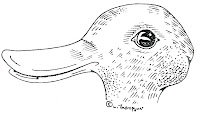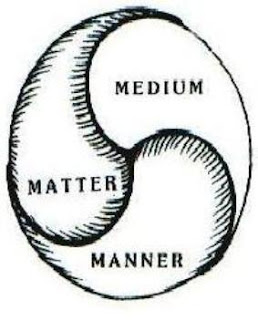In this there is an underlying assumption that we identify
candidates [as art] by subsuming them under a definition. That definition is one that many philosophers
have supposed we possess, if only implicitly, and that we apply to candidates
tacitly. Successive Theories have
attempted to recover it and make it explicit.
Clearly, a certain view of the nature of concepts underwrites all these
attempts. Concepts are regarded as
essential definitions. That is, concepts
are taken to be definitions that supply necessary and sufficient conditions for
membership in the category they designate.
Art is a concept; so, the story goes, the concept of art must have
necessary and sufficient conditions for application to particular instances. Noël
Carroll , Philosophy of ART,
Routledge (1999) pp250
The concept of ‘art’ has
evaded, scholars, artists, academics, critics and philosophers from the time
the first caveman placed a hand print on a cave wall. Most of the problems lie with those who fail
to consider what goes into making art but let’s look at what a concept of art
entails. Fundamentally a concept is an abstract idea; it is an archetypal
construct that sets limits that help us perceive and identify certain species
as being of a kind. As I have mentioned
in previous posts, it is a categorial term (meaning having to do with
categories). Our task now is to unpack
the notion of art to discover what conditions are necessary and what are
sufficient to allow us to recognize when something is or is not a work of art.
Understanding the Art ‘Form’
'Form'
is a term that is widely used by practitioners of the arts and it is the key
term for understanding the concept of art. Theatre practitioners, dancers,
musicians, visual artists, sculptors commonly refer to their activity as taking
place within an art form. When asked
what art form they work in they readily answer without confusion. They know
that Theatre is an art form or Dance is an art form. Indeed, when speaking of their work it is not
unusual for them to just speak of their form.
How is it such diverse practitioners can use the same concept - art form
- to describe their work? What is common
between theatre, the visual arts, dance, music and sculpture, et al that allow
us to describe them with the same concept? It has long been held that a statue
does not share anything in common with a theatre production or a novel but the
argument is wrong and most practitioners of the arts know it. But Noël
Carroll finds this argument somewhat specious for he attacks the view
that something is art only if it possesses and exhibits form.
But this is
extremely unhelpful. It does not provide
a necessary condition for art, since there are artworks – like the monochrome
paintings of Ad Reinhardt, Yves Klein and Robert Ryman – that have no
parts.(they are blocks of single colors.)
Moreover, reading the formalist’s theory in this way would defeat any
hope of his securing a sufficient condition for art, since everything that has
parts probably has form in the loose sense, and not everything is art.”(121)
Carroll
is trying hard but he has missed the mark.
What he fails to recognize is that not only do all art works have parts they also have aspects.
Aspects of Art
A sketch similar to the above diagram which
was first used by the psychologist Jastow and made famous by the philosopher
Ludwig Wittgenstein, is known as the duck-rabbit figure. Wittgenstein argued that you only see the
duck or rabbit in the diagram if you are already conversant with the shapes of
those two animals.
Wittgenstein was at pains to point out that the duck and the
rabbit are not two pictures. Rather they
are one diagram with two aspects. An aspect is a point of view. You may view the diagram as a duck or you may
view it as a rabbit. You may also see
both aspects simultaneously which is the situation of someone who was not familiar
with both the shape of a duck and rabbit.
I offered this example to help clarify the notion of aspects for all
works of art have aspects but unlike the duck/rabbit diagram works of art have three aspects.
Aristotle
noted over two thousand years ago that tragedy had three aspects which we can
describe as the manner of presentation, the medium of presentation and the
object of presentation. Aristotle used
the term imitation rather than presentation but Aristotle’s use of the term
imitation does not merely mean a copy or likeness. Aristotle understood we could imitate things
that never before existed. While
imitation is a perfectly good term as Aristotle understood it, I have changed
it to presentation to avoid confusion. I have changed object to matter, meaning
subject matter. Aristotle believed that
form was contained within an object which provided us a means of identifying
it. What Aristotle failed to mention was
that all works of art contain a
medium of presentation, a manner of presentation and subject matter of
presentation. These represent the three
aspects of an art work and help us identify its art form.
Just
as we may attend to the duck aspect in the diagram above ignoring the rabbit we
may attend to the subject matter in a painting, sculpture, dance, theatre
production or any other art form ignoring the other two aspects. These three aspects are the aspects of form
that Carroll missed. Each aspect of a
particular art form has its individual constituent parts determined by the
medium used which in turn limits the methods and techniques that may be applied
(the manner). Artists are forever
searching out new mediums which demand different methods and techniques. The diagram below relates to the theatre but
it shows how the different parts of a theatre production are contained within
the different aspects of a theatre production.
This
diagram represents the art form of theatre.
In the theatre Aristotle recognized that the manner of presentation
deals with such things as set, costumes, lighting design, masks and make-up,
acting, movement, voice and speech
techniques, performing methods and styles as well as the design of the theatre
and stage. Clearly this list is not all
inclusive and not all parts are used in every production but it sets out the
types of things included in the manner of presentation. Obviously such things as voice and speech
techniques will contribute to characterization which is a part of the subject
matter of a production. The thing to
remember is that the medium, the manner and the matter along with their
constituent parts allow us to distinguish one art form from another. For the most part it is the medium that
determines the art form we are looking at but Literature and Theatre share the
same medium which is language however they differ in their manner of
presentation. (This is one reason play
scripts are studied in literature courses.)
It is not unusual that persons will go to the theatre to watch the
characters and involve themselves in the plot but seldom concern themselves
with how the lighting is accomplished and the effect it has on characterization
or setting or if the make-up is effective, over-done or lacking in some
way. Generally audiences only notice
such things if they are striking. They
seldom make it a point to evaluate what they believe to be commonplace. Often they are not conversant with such
things as costume and lighting design or set design. Seldom do they realize
that a touring set has to be designed differently to a set designed for a
particular theatre. Much as a person not
conversant with the shape of a rabbit, say, will not see the rabbit in the
diagram above, audiences who are not conversant with the demands of set,
costume and lighting design will not see nuances or the subtle shades of
meaning in these constituent parts of a
theatre production.
Failing
to recognize that works of art have three aspects limits our ability to
understand the concept of art. This was
the problem Carroll confronted when he insisted that the monochrome works by
artists such as Ad Reinhardt and Yves Klein have no parts and consequently no
form. A 1956 work of Reinhardt is like
the one below and seems to the uninitiated to be merely a blue rectangle. It’s a small work about 9 inches by 4 ½
inches.
The
size of the work should lead us to suspect something different is going on with
Reinhardt’s painting and when we discover that Reinhardt’s medium was Gouache
(pronounced g’wash) painted on photographic paper we are able to admire the skill of the artist. Gouache is a watercolor paint used with a
binder (probably gum Arabic). Gouache
will not allow the glossy whiteness of the paper to show through. Pigments in the gouache will lighten in the
drying which makes Reinhardt’s accomplishment even more impressive. It’s possible that he applied more than one
coat. We aren’t told how the paper is
mounted but this would be a significant consideration as the binder may have a
deleterious effect on the paper. Yves
Klein’s Blue painting is oil on canvas on wood.
In both cases the medium is significant to the manner of presentation
and consequently the subject matter.
Yves
Klein developed (with a group of chemists) and patented his own special
ultramarine blue which he called IkB.
Suspended in a synthetic resin it maintains its color wet or dry. For
Klein it was the purest of blue. Today
we recognize several types of blue; Cobalt, Prussian, azurite or ultramarine
are the most well-known. Blue pigment
has a special significance for artists; it was one of the most difficult and
most expensive pigments to come by for it has always been a synthetic pigment
first developed by the Egyptians. For
alchemists of the 14th century it was pigment valued as highly as
gold. Blue lapis lazuli from Afghanistan
ground to a powder was put through a difficult and demanding process until a
pigment called ultramarine emerged. It
wasn’t until late 1800 that an industrial process was invented which brought
down the price of this valuable pigment.
In
most of our art forms how they are presented; the frame chosen for a painting
or how it is lighted are a significant part of the manner of presentation.
After all, a painting in a pitch darkened room reflects no color at all and
cannot in situ be described as a work of art.
Below
is a similar diagram for the visual arts but as medium is the defining
characteristic of an art form we need to recognize that an oil painting is a
different art form from fresco which is a different art form from water color
which is a different art form from tempera, etc. Each of these different art forms use
different techniques, methods and tools as part of their manner of presentation
though they all may show us the same subject matter from the same point of
view. What is important is that all art
forms share common aspects but differ in their constituent parts. Clive Bell asserted that “…either all works
of art have some common quality, or when we speak of ‘works of art’ we gibber.” Bell, Clive, Art, Capricorn, New York (1958) pp17.
The
important point here is to remember that the medium used greatly affects the
end product. Different mediums require
different techniques and often different tools to embellish the work. Consider this exercise below which was
accomplished with several different mediums.
To Be continued…..
Launt Thompson
http://www.amazon.com/s/ref=nb_sb_noss?field-keywords=Launt+Thompson&url=search-alias%3Daps&x=16&y=9







No comments:
Post a Comment